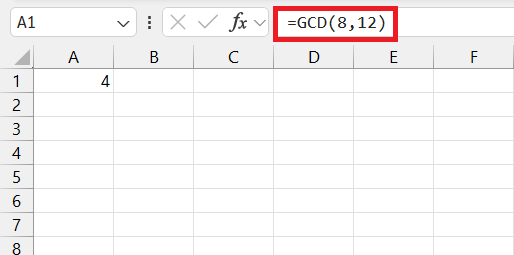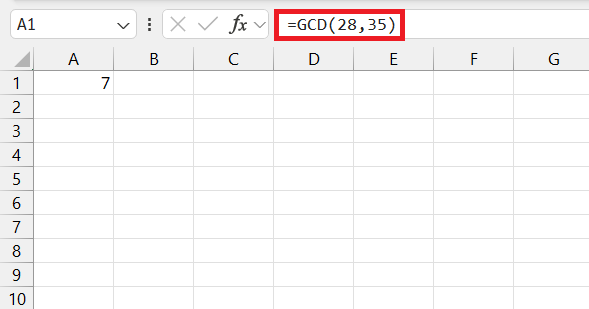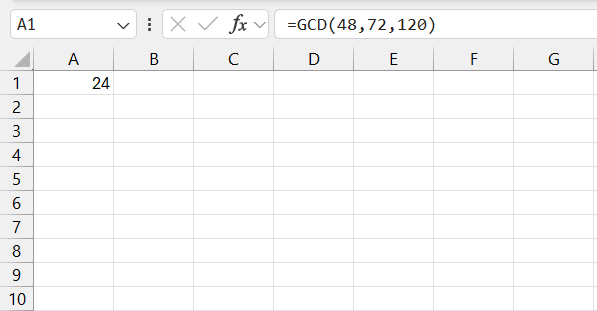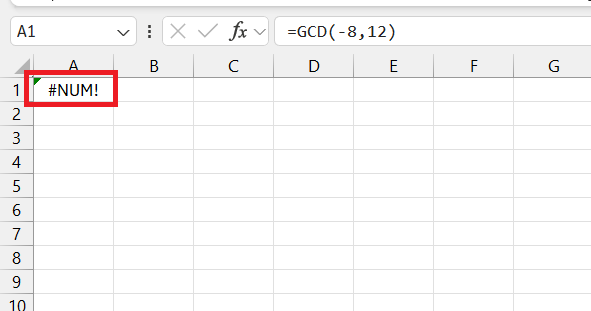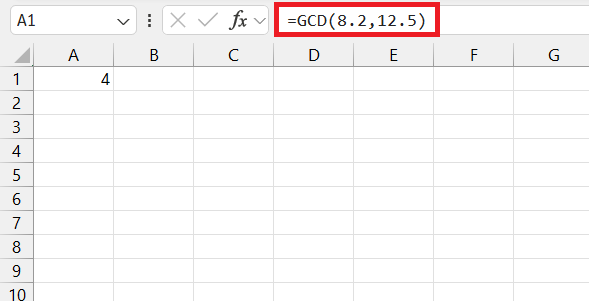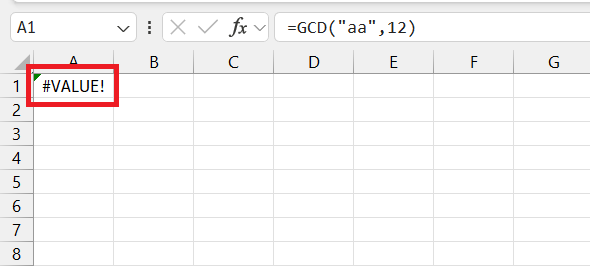Mastering the Microsoft Excel GCD function is essential for simplifying fractions and comparing ratios. GCD, or Greatest Common Divisor, calculates the largest integer that divides two or more numbers without a remainder, making it a crucial tool for finding common denominators and simplifying mathematical expressions.
Key Takeaways:
- Understanding GCD: The GCD is the largest number that can divide two or more integers without leaving a remainder, simplifying fractions, and finding common denominators.
- Basic Usage: Use the formula =GCD(number1, number2) to find the GCD of two numbers. For example, =GCD(28, 35) returns 7.
- Multiple Numbers: The GCD function can handle multiple values, such as =GCD(48, 72, 120), which returns 24, the largest number dividing all three values.
- Practical Applications: The GCD function is valuable in fields like finance, science, and everyday problem-solving, simplifying fractions, calculating ratios, and optimizing resource distribution.
- Common Errors: The GCD function cannot handle negative numbers or non-numeric values. Ensure inputs are positive integers to avoid errors like #NUM! or #VALUE!. Excel truncates decimal inputs to whole numbers, but it’s best to input integers directly.
Table of Contents
Introduction to the Excel GCD Function
The Role of GCD in Excel Calculations
When you’re dealing with multiple numbers, especially when simplifying fractions or comparing ratios, having a command over the Excel GCD function can be incredibly powerful. GCD stands for Greatest Common Divisor, and in Excel, it plays a pivotal role. It calculates the largest integer that divides two or more numbers without leaving a remainder, making it an essential tool for anyone looking to find common denominators or simplifying mathematical expressions.
Understanding the Basics of the Greatest Common Divisor
The concept of the Greatest Common Divisor (GCD) might sound daunting at first, but once you get the hang of it, you’ll find it quite straightforward. Fundamentally, the GCD is the largest number that can divide two or more integers without any leftovers—think of it like finding the biggest piece of a pie that can be evenly shared. In practical terms, if you’re looking at numbers like 8 and 12, their GCD would be 4 because it’s the biggest number that fits into both without leaving anything behind.
In essence, GCD helps in simplifying fractions by reducing them to their lowest terms. It’s also critically important in various branches of mathematics and computer science, such as in algorithm design and number theory. Understanding how to compute the GCD means you’re able to streamline and solve many numeric problems more effectively.
Step-by-Step Examples
Calculating the GCD of Two Numbers
When you’re focused on just a pair of numbers, calculating the GCD in Excel is delightfully straightforward. Start by selecting the cell where you want the GCD result to live. Then, type in the GCD formula followed by your two chosen numbers, separated by commas.
Imagine you have 28 and 35 as the two numbers you’re playing with. You’d type =GCD(28,35) into your cell. When you hit enter, Excel performs the calculation and returns the number 7, since 7 is the largest number that fits neatly into both 28 and 35.
This functionality can be immensely helpful in various settings. Whether it’s financial analysts working out ratios, scientists computing ratios of mixtures, or even students solving their math homework, the ability to quickly calculate the GCD of two numbers is a significant time-saver and adds clarity to the data you’re working with.
Always remember: Excel is designed to make your numbers work for you, not against you. And with the GCD function, it’s all about bringing harmony to your figures.
Finding the Largest Common Factor for Multiple Values
When you’ve got more than just a couple of numbers to contend with, that’s when the GCD function truly shows off its strength. Calculating the largest common factor for a group of values is just as easy as with two numbers, and it can bring a sense of unity to your dataset.
Simply enter the GCD formula into a cell and list all the numbers you’re investigating, separated by commas. Say you have a sequence like 48, 72, and 120. You’d input =GCD(48,72,120), and voilà! Excel will immediately compute and reveal the GCD, which is 24 in this case.
This comes in handy when dealing with group activities where shared resources or time slots are negotiated, or when you need to initialize timers in synchronized systems. The GCD tells you the frequency at which events or actions will naturally align.
Just like that, Excel’s GCD function simplifies your numbers and aligns them, showcasing the common threads between them. This simplification is often a great starting point for deeper analysis and problem-solving.
Practical Applications of Excel’s GCD Tool
Simplifying Fractions and Ratios with GCD
Simplifying fractions can be a breeze with the use of Excel’s GCD function. Have you ever stared at a fraction like 16/24 and wondered how to make it less clunky? You’d call on the GCD to find that both numbers share a greatest common divisor of 8. By dividing the top and bottom by 8, you’d shrink that fraction down to a much neater 2/3.
In the world of ratios and gear teeth—if you’re into mechanics or even photography—the GCD function once again proves invaluable. Just like with fractions, if you have two gears with 30 and 45 teeth respectively, their GCD would be 15, and suddenly you’re looking at a simplified gear ratio of 2:3.
It isn’t just about making numbers look prettier; it’s about efficiency and comprehension. Simplifying fractions helps in comparing them, making them far easier to understand, visualize, and apply, whether you’re baking or building bridges.
So, next time you’re confronted with a fraction that’s larger than life, remember the GCD function is there to scale it down to something more digestible, and more manageable for your mathematical tasks.
Leveraging GCD for Mathematical Problem-Solving
When it comes to dealing with numbers, GCD isn’t just a tool; it’s a strategy for tackling complex mathematical problems. Think of those times when you’ve had to deal with puzzles involving prime numbers or needed to calculate ratios that just didn’t add up easily—GCD is your secret weapon here.
For example, let’s say you’re a teacher trying to split students into groups for a project, and you want these groups to be even. If you have supplies that can be shared among a certain number of students without leftovers, finding the GCD of the supply count and the student count ensures that no resource goes to waste.
Or, if you’re in carpentry, ensuring you cut wood into lengths that maximize material usage—the GCD can ensure all pieces are cut to lengths that fit together with the least waste.
By regularly incorporating the GCD function in your problem-solving toolbox, you become more adept at identifying the most efficient routes to finding solutions, making your work smoother and your time well spent.
Whether it’s geometry, distributing resources, or optimizing workflows, the GCD function stands as a testament to how a simple mathematical concept can have wide-reaching applications across various scenarios.
Tips and Tricks for Using GCD Effectively
Common Mistakes to Avoid With the GCD Function
Even the most experienced Excel users can sometimes trip up when working with functions like GCD. To keep your calculations smooth and error-free, be aware of common pitfalls:
Firstly, remember that GCD can’t work with negative numbers. Inputting a number less than zero will result in a #NUM! error, as the concept of division doesn’t play nicely with negatives in the realm of common divisors.
Secondly, while Excel automatically truncates decimal values entered as parameters into whole numbers, it’s still a better form to ensure you input integers from the get-go. This avoids any unintended results and keeps your workbook clean.
Lastly, be careful with non-numeric entries. If you accidentally feed text or an empty cell into the GCD function, you’ll face a #VALUE! error. Make sure all your arguments are indeed numbers.
By keeping these tips in mind, you save yourself from frustration and keep your workflow efficient. It’s all about precision—keeping the inputs clean to ensure the outputs are just what you need.
Frequently Asked Questions
How to find the greatest common divisor in Excel?
To find the greatest common divisor in Excel, first select the cell where you want the GCD result to be displayed. Then, enter the GCD formula =GCD(number1, number2), replacing number1 and number2 with the actual numbers you’re evaluating. You can add more numbers as needed, separated by commas. Press Enter, and Excel will return the GCD of your given numbers. It’s that simple! If you’re working with a range of cells, you can reference them directly in the formula, like =GCD(A2, A3).
What is the GCD format in Excel?
In Excel, the format for the GCD function is GCD(number1, [number2], ...). You start with =GCD( and follow it with the number arguments for which you want the greatest common divisor. The first number is required, while additional numbers are optional. The arguments can be up to 255 numeric values and, if they’re decimals, Excel truncates them to integers. Close the parenthesis and press Enter to obtain the result. For example, =GCD(20, 30) would return 10.
How Does Excel Determine the Greatest Common Divisor Among Cells?
Excel determines the greatest common divisor (GCD) among cells by using the GCD function and referencing the cells containing the relevant numbers. If you’ve got your numbers in cells A1, A2, and A3, for instance, you’d input =GCD(A1, A2, A3), and Excel will do the heavy lifting. The function will compare the numbers and calculate the largest integer that can evenly divide all the cell values, showing the result in the cell where you entered the formula. This method is incredibly handy for working efficiently with large datasets or groups of numbers that are dynamically changed.
Can Excel’s GCD Function Handle Non-Integer Values?
Yes, Excel’s GCD function can handle non-integer values, but with a little twist—any decimal numbers you input will be automatically truncated to whole numbers before the calculation. For example, if you enter =GCD(8.5, 12.75), Excel will interpret it as =GCD(8, 12). This means you won’t have to worry about rounding numbers as Excel preps them for you, ensuring that the GCD function works seamlessly even if your data isn’t perfectly formatted as integers.
Can Excel’s GCD Function Handle negative values?
No, Excel’s GCD function cannot handle negative values. When provided with negative numbers as arguments, the GCD function will return a #NUM! error because it only operates on positive integers. The numbers supplied must be non-negative, and any decimal values given to the function will be truncated to their integer components.
John Michaloudis is a former accountant and finance analyst at General Electric, a Microsoft MVP since 2020, an Amazon #1 bestselling author of 4 Microsoft Excel books and teacher of Microsoft Excel & Office over at his flagship MyExcelOnline Academy Online Course.

